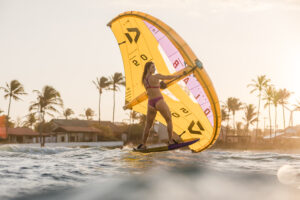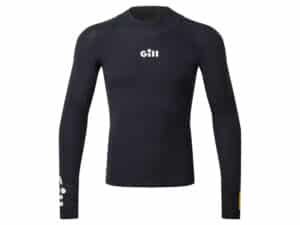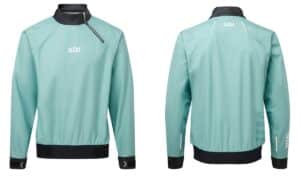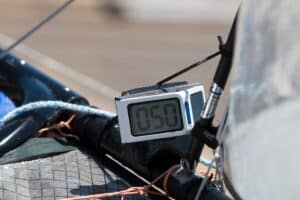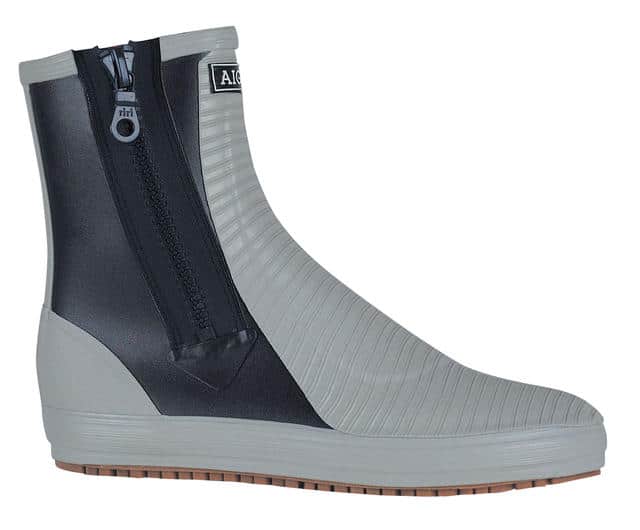
Aigle Bora
Sailing boots are the unsung heroes of dinghy sailing: ridden hard, put away wet, and smelly, and somehow expected to last through seasons of abuse from hiking straps, gravel parking lots, and general disregard. No environment is harsher on this essential equipment than college sailing. Last fall, on a mission to determine the best dinghy boot on the market, I collected five major brands and let my teammates at St. Mary’s College of Maryland abuse them for the spring season. This became one of the toughest tests any dinghy gear could undergo. We used these boots almost everyday for five months in FJs and 420s. Our test period included days in February when rigging included chipping ice out of the bottoms of our boats and days in May when going for a swim in the river was a welcome relief from the stifling humidity. We hiked hard off of these boots on windy afternoons, and we gracefully maneuvered them through roll tacks during light air boathandling drills. A season of college sailing provided the ultimate dinghy boot test—a wide range of conditions, an extended duration for wear, and a group of sailors aware of the value of high quality gear. Here is what we found.
Aigle Bora
Aigle is best known for its lace-up Maramu boot, but the Bora (pictured above, right) challenges this classic with high ratings in both warmth and comfort. With a rubber exterior and 4mm neoprene interior, the boot kept toes warm in the coldest conditions. The boot was very supportive for hiking, and fit comfortably with drysuits or bare feet. The Bora has a zipper, rather than laces, and seems to have been designed for sailors with small ankles. The zipper and neoprene necessitate a post-sail rinse-off to ward away corrosion and funky odors. But with this small amount of maintenance, the Bora easily withstood the test. While at the upper end of the price range, they are a worthwhile investment. $135
The verdict: “The neoprene provides soft padding as well as great insulation. Having a layer between your foot and the thick hard rubber prevents your body heat from being sucked out of your feet. They are a little smaller than my Maramus. I had a hard time pulling the zipper all the way up—if I had a drysuit on, I left them unzipped.” –Megan Magill
Ronstan Race Boot
Ronstan’s Race Boot strikes a good balance between support, comfort, and durability. Reinforced neoprene provides excellent support for hiking and also makes the boot comfortable in all seasons. With a side zipper, the boot was easy to pull on and off. Once on, there’s no need to worry about readjusting, as a tab at the top of the boot holds the zipper in place. The boot has a flexible fit, working well with and without a drysuit. Flexibility also characterizes its sole, which is textured to provide a good grip. The Race Boot transitioned nicely from dinghies to bigger keelboats, with one of our offshore teammates testing it on Navy 44s, J/109s, and SR33s. The boot lasted well throughout the test, with minor wear on the upper, non-reinforced neoprene. At a reasonable price, the Race Boot will fit those looking for the flexibility of an all-season option. $75
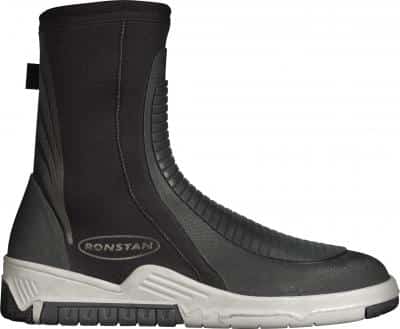
The verdict: “They are very flexible, which is compatible to the different styles of hiking I have in Lasers and doublehanded boats. They are also comfortable, and the neoprene allows them to stretch a little so that my feet don’t feel too cramped if I am wearing a drysuit.” –Mayumi Roller
**Slam Sea Perch **
With its neoprene and rubber construction, the Sea Perch provides plenty of support for hiking and warmth in cold climates. The boot has a side-zip closure and a Velcro belt that adjusts the fit around the top of the foot. These adjustments made the Sea Perch comfortable, and the boot fit especially well when worn over a drysuit. The boot proved to be durable throughout the season, but the Velcro belt tore off at the end of our trial. While appropriate for most of our sailing season, the weight and support of this boot made it feel clunky when the temperatures rose and the drysuits came off. $65
Ed. Note: As of press time, the Sea Perch was still available at several retailers, but Slam reports that they are discontinuing the boot for next season. Instead, they will offer a Skiff line including high-cut ($50) and low-cut ($45) neoprene boots designed for performance sailing.
Sperry Top-Sider Submersible
Sperry is new to the dinghy boot market and has brought a different approach to their footwear. The Submersible Boot garnered high ratings in both comfort and support with its neoprene construction and rubber outersole. The rubber outersole consists of grooves that provide better traction on the sole and more support on the top of the foot and ankle for hiking. Sperry also added drainage ports to the soles of the boots, which kept them cool in warm weather but required the use of dry socks in cold weather. The durability of Sperry’s boots could still use improvement. After three months, the zipper ripped and holes were torn in the neoprene. Fortunately, Sperry is dedicated to its customers and gave my teammate a free replacement pair after they saw the damage he had done. $80
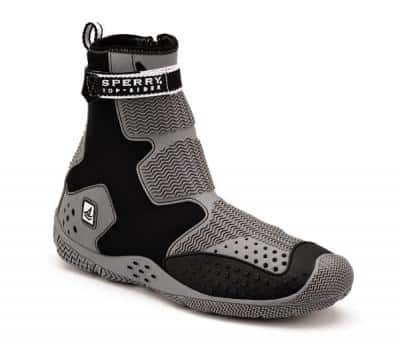
The verdict: “The soles have nice arch support, and the ankles give support while still being flexible. The rubber grip across the top of the foot and ankle gave me extra grip on the hiking strap. The only questionable feature is the drainage holes located in the bottom of the boots and on the side. This feature can be very nice in warm weather—eliminating boot juice and keeping feet cool—but when its cold, this gives you wet feet.” –John Wallace
Zhik Soft Sole Boot 250 (now 260)
Zhik recently redesigned their line of dinghy boots, including the pair that we sailed with. The 250 model received high marks, so the enhancements in the 260 are sure to make it even better. Both versions of Zhik’s boots are made with a unique side-lacing system that resembles ballet slippers. After you pull the boots on, you can make the fit as tight or loose as you want. An ankle strap at the top of the boot can be tightened to provide more support for hiking. In their 260 model, Zhik made this strap wider for more support and integrated it with the rubber upper. Zhik also makes a hiking strap that meshes with their boot, effectively “locking you in” to the hiking strap. While Zhik provides a range of adjustments for fit, the actual width of the boot is relatively narrow, and my teammate had to go one size up. Zhik’s boot is made with 4mm neoprene, which functioned well in warm weather but allowed water to seep in. Like Sperry’s model, the Zhik boot requires a good dry sock in colder weather. The boot was relatively durable—the only wear and tear involved several small holes that formed in the neoprene around the lacing system. $89
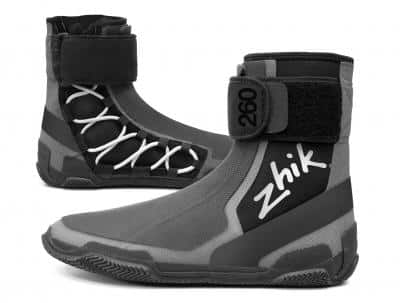
The verdict: “I like the lacing system. The boots give you a great feel in the boat and are super grippy and lightweight. They are better for summer than winter; when you wear them without dry socks, they fill up with cold water and stay cold during the winter months.” –Maddie Jackson

